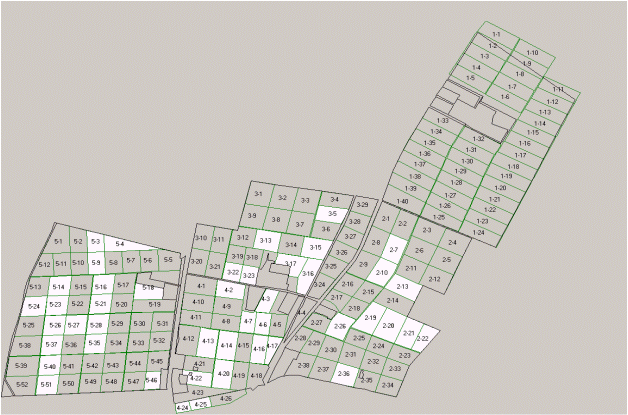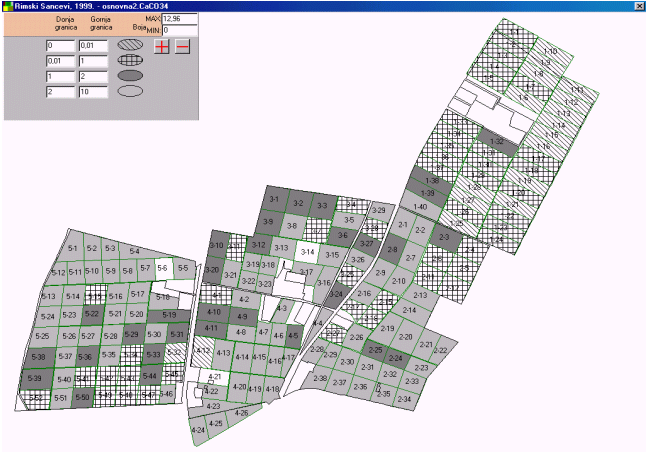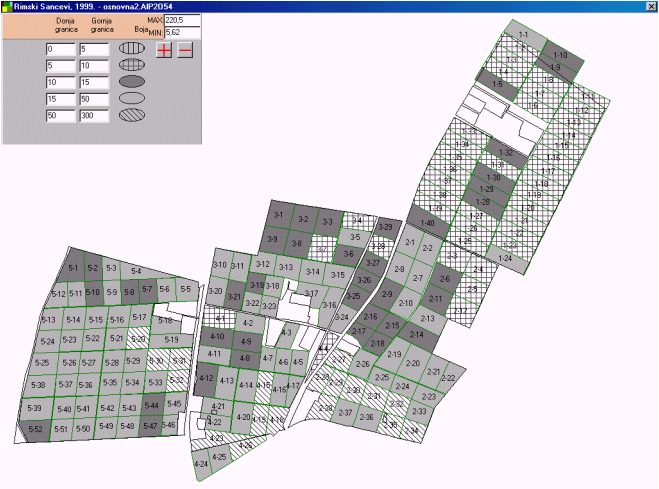[P-002]
SOIL CONDITIONS NECESSARY FOR SEED PRODUCTION OF MEDICINAL HERBS
AT THE EXPERIMENT FIELD OF THE INSTITUTE OF FIELD AND VEGETABLE CROPS IN
NOVI SAD
Petar SEKULIĆ, Jovica VASIN and Jordana RALEV
Institute of Field and Vegetable Crops, Maksima Gorkog
30, 21000 Novi Sad, FR Yugoslavia
ABSTRACT
Following land surveys and on-site investigations, soil profiles have
been opened to establish the global soil fertility status and the presence
of hazardous and harmful substances at the level of the experiment field.
Based on the analyses of water-physical and chemical properties of the
samples taken in the profiles, soil types have been identified and a soil
map at the level of soil form has been made. To get a better insight in
the soil fertility status and the distribution of hazardous and harmful
substances, the experiment field has been subdivided in 3-5 ha elementary
plots. Samples from the profiles and those taken for soil fertility testing
have been analyzed for the contents of microelements and heavy metals.
Based on the criteria for the production of safe food, recommendations
have been made and maps have been drawn of the areas in which the selection
and seed production of medicinal herbs may be conducted without risk of
contamination of their vegetative and/or generative parts. Taking in account
the soil requirements of individual medicinal crops, most favorable plots
have been identified at the experiment field and their locations have been
mapped.
Key words: fertility, microelements, heavy metals, medicinal
herbs.
INTRODUCTION
Optimum conditions are needed for a successful seed production. While
seed quality and genetic purity are secured by spatial isolation, yield
quality and level depend on soil conditions. Seed production should be
organized in field with a soil possessing good biological, physical and
chemical properties. For a successful breeding and seed production of medicinal
herbs, it is necessary to have a quality soil, rich humus, a regulator
of soil physical properties and a source of essential elements (Brabenec,
1983). According to Tucakov (1984), there are eighteen requirements that
should be met in order to achieve high quality of medicinal herbs. The
requirement that concerns soil calls for a high quality irrigable soil.
The objective of this study was to quantify the optimum soil properties
needed for achieving high yields of medicinal herbs on the basis of an
analysis of fertility parameters of production plots taken from a database
gathered for the development of a soil map of Rimski Šančevi Experiment
Field.
MATERIAL AND METHODS
Following preparatory activities, a team of soil scientists determined
the coordinates of observation points where soil profiles were dug. The
profiles were made conventionally, to the depth of 2 meters. After taking
photographs and making morphological descriptions, undisturbed and disturbed
soil samples were taken from different horizons for laboratory analyses.
A total of 42 profiles were made. The next step was to locate the elementary
plots for soil fertility control. They varied in size from 3 to 5 hectares.
In the 189 elementary plots thus established, soil samples were taken from
the depth 0-30 cm. Physical, chemical and microbiological properties of
the samples were analyzed in the Laboratory of Agroecology, Department
of Soil Science, Agroecology and Mineral Fertilizers, Institute of Field
and Vegetable Crops, using methods accepted by the Yugoslav Society of
Soil Science (JDPZ).
RESULTS AND DISCUSSION
Map 1 shows that 44 plots from the Experiment Field meet the criteria
for optimum soil properties needed for the breeding and seed production
of medicinal herbs. The total size of these plots was 124.59 ha. In other
words, 24% of the total area of 600 ha of Rimski Šančevi Experiment Field
were found to possess optimum conditions necessary for the breeding of
medicinal herbs and for obtaining high and stable seed yields. The key
question was - which soil properties depart from the optimum values? The
analysis provided the following answer: soil reaction, contents of humus
and CaCO3 and soil provision with available P2O5
and K2O.
The criterion set for pHKCl was the interval from 6.5 to
7.5. Map 2 shows that the optimum pH was found in 137 plots. Slightly acid
reaction (pH 5.5.-6.5) was found in 26 plots, acid reaction in 1 plot,
alkaline reaction in 5 plots. This was an indication that, with the exception
of plot no. 3495, soil reaction is not a limiting factor for seed production
of medicinal herbs in the plots of the Experiment Field. Plot no. 2-5 and
the neighboring plots 2-4 and 2-12 should be treated with 10 t/ha of CaCO3
in order to bring the soil reaction in them to the minimum level of 6.5.
The content of free CaCO3 (Map 3) was in correlation with
soil reaction - plots with low pH contained no free CaCO3. The
level of CaCO3 up to 2% was registered in 95 plots. This criterion
should be set at a level higher than 2% in order to ensure stability in
soil structure and favorable water-air regimen. Map 3 shows that free CaCO3
was absent in 17 plots. The problem may be overcome by liming.
Optimum humus content, higher than 2% and with the mean value of 2.85%,
was registered at the entire territory of the Experiment Field. Only one
plot had the humus content of 1.99%.
Soil provision with ammonium-lactate-available phosphorus was variable.
Map 4 shows that the level of Al-P2O5 optimum for
seed production of medicinal herbs was found in 88 plots with the total
size of 283,7 ha. Furthermore, 18 plots had the content of Al-P2O5
above 50 mg/100g of soil. If these plots are to be used for seed production,
phosphorus fertilization should be omitted in them. The phosphorus contents
below 15 mg/100 g of soil was found in 41 plots. The mean content in them
was 12.58 mg/100g. These plots do not meet the criterion for optimum phosphorus
content, but it may be easily compensated with intensive phosphorus fertilization.
The costs of extra phosphorus fertilization will affect the economy of
seed production in the year of application but, because of the effect of
soil reserve associated with phosphorus, this practice will improve the
total fertility of soil.
Map 1.
Plots at Rimski Šančevi Experiment Field possessing optimum
soil properties for seed production of medicinal herbs

Map 2. Soil reaction (pH KCl)
at Rimski Šančevi Experiment Field

Map 3. Content of free CaCO3
(%) at Rimski Šančevi Experiment Field

Map 4. Content of Al-P2O5
(mg/100g) at Rimski Šančevi Experiment Field

On 39 plots the content of P ranged in the interval from 5 to 10 mg/100g
of soil. The mean value was 7.96 mg/100g. It was recommended for these
plots to be omitted from the program of breeding and seed production of
medicinal herbs. Such production is not sufficiently accumulative to cover
the costs of the necessary level of phosphorus fertilization.
The content of potassium was suitable for the breeding and seed production
of medicinal herbs in almost all plots. Exceptions were 8 plots with the
content of ammonium-lactate-available K2O above 50 mg/100g of
soil. However, the mean content for these plots, which was 57.5 mg K2O
/100g, cannot be a limiting factor for the breeding, seed production and
production of planting material of medicinal herbs.
The contents of microelements (Cu, Zn, Mn, Mo) were at the optimum level
or a high level on the entire territory of the Experiment Field.
The contents of the analyzed available and total heavy metals (Cd, Pb,
Cr, Ni) were far below the values of minimum allowed concentration (MAC).
Therefore, the Experiment Field is suitable for a risk-free and high production
of quality seed and planting material of medicinal herbs. Favorable conditions
and optimum levels of provision with biogenous elements ensure the profitability
of such production.
CONCLUSION
The following conclusions were drawn.
Optimum soil conditions for the breeding and seed production of medicinal
herbs exist at the area of 142.59 ha.
Soil reaction below pHKCl=6.5 and absence of free CaCO3
may affect the profitability of production in some plots.
The soil of the Experiment Field is well provided with humus, available
microelements and potassium.
Phosphorus provision is highly variable. A part of the plots has an
optimum content of available P, the other part requires fertilization with
P2O5.
The contents of available and total heavy metals are far below the values
of minimum allowed concentration (MAC), allowing a risk-free production
of high quality seed of medicinal herbs.
LITERATURE
Barbarec M. (1983): Pestovanie liečivych rastlin
na malych plochach, Svepomoc Praha.
Sekulić P., Hadžić V., Kišgeci J.(1998): Zemljišni
uslovi za proizvodnju lekovitog bilja u opštini Bački Petrovac. Zbornik
radova Lekovite sirovine. XIII, 55-61.
Tucakov J. (1984): Lečenje biljem, Izdavačka
radna organizacija "Rad", Beograd.
[P-002]



